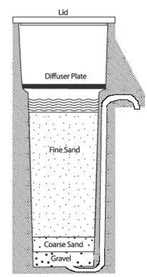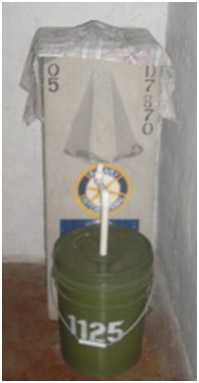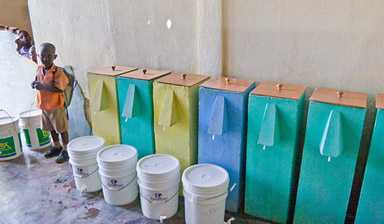Slow Sand Filtration

Slow sand filter schematic (CAWST)
Slow Sand Filtration [PDF – 2 pages]
A slow sand filter is a sand filter adapted for household use. Please note that although commonly referred to as the BioSand Filter, the BioSand Filter terminology is trademarked to one particular design, and this page encompasses all slow sand filters. The version most widely implemented consists of layers of sand and gravel in a concrete or plastic container approximately 0.9 meters tall and 0.3 meters square. The water level is maintained to 5-6 cm above the sand layer by setting the height of the outlet pipe. This shallow water layer allows a bioactive layer to grow on top of the sand, which contributes to the reduction of disease-causing organisms. A diffuser plate is used to prevent disruption of the biolayer when water is added. To use the filter, users simply pour water into the top, and collect finished water out of the outlet pipe into a bucket. Over time, especially if source water is turbid, the flow rate can decrease. Users can maintain flow rate by cleaning the filter through agitating the top level of sand, or by pre-treating turbid water before filtration.
Lab Effectiveness, Field Effectiveness, and Health Impact
Slow sand filter lab effectiveness studies with a mature biolayer have shown 99.98% protozoan, 90-99% bacterial, and variable viral reduction. Field effectiveness studies have documented E. coli removal rates of 80-98%. Two health impact studies report 44-47% reduction of diarrheal disease incidence in users. Experience has shown proper filter maintenance is necessary for optimal performance so proper user training and follow-up is critical to filter success. Since the filter is typically used without subsequent chlorination, training users to properly care for and maintain a safe storage container is necessary.
Benefits, Drawbacks, and Appropriateness

Commercially available slow sand filter (Hydraid™)
The benefits of slow sand filtration are:
- Proven reduction of protozoa and most bacteria
- High flow rate of up to 0.6 liters per minute
- Simplicity of use and acceptability
- Visual improvement of the water
- Production of sufficient quantities of water for all household uses
- Local production (if clean, appropriate sand is available)
- One-time installation with low maintenance requirements
- Long life (estimated >10 years) with no recurrent expenses
The drawbacks of slow sand filtration are:
- Not as effective against viruses
- No chlorine residual protection – can lead to recontamination
- Routine cleaning can harm the biolayer and decrease effectiveness
- Difficult to transport due to weight – high initial cost
Slow sand filtration (SSF) is most appropriate where there is funding to subsidize the initial filter cost, available education for use and maintenance, locally-available sand, and a transportation network able to move the filter.
Implementation Examples

Locally-made concrete slow sand filter (Pure Water for the World)
The BioSand Filter was designed by Dr. David Manz at the University of Calgary.
Samaritan’s Purse is a non-governmental organization (NGO) that implements the BioSand Filter through their Household Water Program by providing managerial and technical assistance as well as project funding to field partners. Since 1998, Samaritan’s Purse has assisted in establishing BioSand Filter projects in 24 countries. As of April 2010, over 116,000 have been installed worldwide.
Samaritan’s Purse’s largest partner, Hagar International, is operating in rural Cambodia installing 15,000 BioSand Filters per year. Hagar invites those interested in receiving a filter to a training meeting where they sign up to receive a filter, are asked to contribute a small amount to their filter ownership, attend group trainings on filter use and hygiene, and send one family member to assist with the construction and transportation of the filter. Samaritan’s Purse has developed an implementation manual and has technical support staff to assist BioSand Filter projects across the world.
Dr. Manz licensed the plastic version of the BioSand Filter to the NGO Hydraid™. They manufacture the plastic containers in Michigan and Honduras, and work with local implementing organizations to import the plastic containers, create the sand filter, and educate users. Pure Water for the World is another NGO working with a different plastic slow sand filter container, made locally in Haiti and Honduras and is also implemented with the help of local organizations.
There are several training centers that promote the SSF. The NGOs Centre for Affordable Water and Sanitation Technology (CAWST) and BushProof both offer training, implementation manuals, and assistance to organizations interested in starting SSF programs.
Economics and Scalability

Slow sand filter system in Haiti (Pure Water for the World)
The average slow sand filter’s construction cost ranges from US $15-$60, depending on whether local or imported materials are used. Filter programs are either fully subsidized or operated at partial cost recovery (with users paying $2-$10) using donor funds. Community motivation, distribution, education, and follow-up can add significantly to program costs. For Samaritan’s Purse, the average overall cost is about $100 USD per filter. Assuming it lasts 10 years and families filter 40 liters per day, the cost per liter of treated water is 0.068 US cents. Some NGOs have worked to train local entrepreneurs to manufacturer, promote, and sell the filters within their communities, although this has met with limited success due to high initial filter expense and difficulty in identifying appropriate local entrepreneurs. Commercial implementation models are currently being explored.
Additional Resources
For more information about slow sand filtration systems for developing countries visit:
- Page last reviewed: March 21, 2012
- Page last updated: May 2, 2014
- Content Source:


 ShareCompartir
ShareCompartir